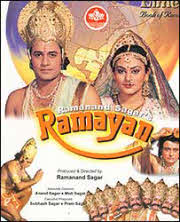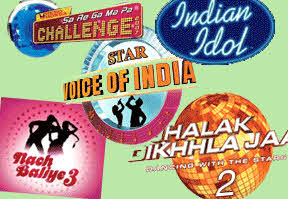by Swetha Ramachandran
[box]It has indeed been a phenomenal journey for Television in India right from the days of The Ramayana and The Mahabaratha to the reality shows of today. Swetha Ramachandran takes us on a walk down the memory lane, touching upon the milestone programmes that have defined the remarkable growth of Television in India. [/box]Deserted roads, absolute silence to be disturbed only with an occasional yelp from a street dog, shops with shutters drawn, no sight of a train or bus moving by! If you grew up in India in the 80s, you probably would be able to relate to this scene. This was how Sunday mornings were like, in most parts of India when in 1987, the epic ‘Ramayana’ began to be aired on television. The country had just been introduced to the wonder box and it was through the serial of ‘Ramayana’, with entire families crowding around, that Indians began their tryst with the television. With manufacturers like Solidaire, Dyanora and Philips being the only ones in the market during the initial days, only a privileged lot owned the wonder box! Owning a television was a luxury and the proud owners would often invite their neighbours to watch a programme or two.
 With the telecast of the serial ‘Ramayana’, based on the Hindu mythological story, television became a great hit with the Indian audience. The actors who played the role of Ram and Sita were worshipped and idolised, and reel life characters became real. The ‘Ramayana’ was followed suit by the ‘Mahabharata’.
With the telecast of the serial ‘Ramayana’, based on the Hindu mythological story, television became a great hit with the Indian audience. The actors who played the role of Ram and Sita were worshipped and idolised, and reel life characters became real. The ‘Ramayana’ was followed suit by the ‘Mahabharata’.
B.R.Chopra’s televised version of the epic bowled the people over with its talented actors who brought to life characters who had remained confined to books till then. It was through these on-screen adaptations that many an Indian kid came to know of the mighty epics. Government-owned Doordarshan (DD) was the only available channel of those times and the broadcaster of these hit serials. Children from the 80s and early 90s will fondly remember getting their general knowledge fix from Siddhartha Basu’s ‘Quiz Time’ and knowing of the latest chartbusters through the Indian film music programme ‘Chitrahaar’ and its Tamil counterpart ‘Oliyum Oliyum’.
With time, DD began to diversify into producing series other than those based on epics. One such massively popular series was ‘Junoon,’ the story of a feud between two wealthy families. Originally telecasted in Hindi, Junoon was soon dubbed into Tamil too. It attracted a great viewership and created a revolution down south for the distinct Tamil it used (in order to match the lip sync), which later came to be known as ‘Junoon Tamil’.
Within a matter of a few years, televisions started to invade each and every house and were no longer considered luxury. Gone were the times when a whole village would gather in front of a single television in awe. Indian television expanded its wings and spotting the opportunity, a number of networks like Sun, Star and Zee set up channels in various Indian languages. With the entry of CNN, NGC and Discovery, Indian viewers got the chance to enjoy the beauty of the Niagara within the confines of one’s home and watch the lion chase a deer without having to visit the African forests. The dawn of the new millennium has been typified by reality shows. Indian channels began to ape British and American shows like ‘Who Wants to be a Millionaire’, ‘American Idol’, coming up with shows suited for Indian tastes. ‘Kaun Banega Crorepati’, the Indian version of ‘Who Wants to be a Millionaire’ completed three successful seasons and is all set for the fourth one too. ‘Indian Idol’, ‘Airtel Super Singer’, ‘Dance India Dance’, ‘Jodi Number One’ and a lot of other shows on the lines of ‘American Idol’ have managed to woo viewers all over India, keeping them on their toes with the extensive drama and talent involved.
Discovery, Indian viewers got the chance to enjoy the beauty of the Niagara within the confines of one’s home and watch the lion chase a deer without having to visit the African forests. The dawn of the new millennium has been typified by reality shows. Indian channels began to ape British and American shows like ‘Who Wants to be a Millionaire’, ‘American Idol’, coming up with shows suited for Indian tastes. ‘Kaun Banega Crorepati’, the Indian version of ‘Who Wants to be a Millionaire’ completed three successful seasons and is all set for the fourth one too. ‘Indian Idol’, ‘Airtel Super Singer’, ‘Dance India Dance’, ‘Jodi Number One’ and a lot of other shows on the lines of ‘American Idol’ have managed to woo viewers all over India, keeping them on their toes with the extensive drama and talent involved.
Western culture continues to exert its influence through reality television shows such as ‘Splitsvilla’ or ‘Rakhi ka Swayamvar’ (a show for celebrity Rakhi Sawant to pick a man to marry) or ‘Pati, Patni aur Woh’. The fame associated with reality shows and the attractive rewards given to the winners have made this genre of television a massive hit in India too. Meanwhile, Indian soaps have managed to remain favourites among Indians, with their regular followers, especially aged people who possess the ability to not get confused between Gita of one serial with Rita of the other!
From black and white Solidaire television sets to Samsung home theatre systems, cable TV to Direct to Home (DTH) services, India has come a long way in the television industry. What with the High Definition programming and recording now available, watching television is no longer an entertainment but an experience. Also, thanks to the telly, the gap between villages and cities has certainly been bridged to a great extent by making villagers aware of everything from technological advancements to the hottest gossip in the film industry! This wonder box has indeed broadened the thoughts and views of people by exposing them to what is happening outside their country too.
Wonder what it will be next! 3-D televisions are already available in the market, so is it going to be just a while before we all sit at home, 3-D glasses on, maybe watching the arrows from Ramayana zoom right through into our eyes?





